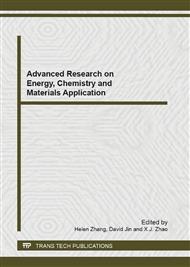[1]
Wenmin Zhou, Deqian Fu, Zongguang Sun. Determination of priority pollutants blacklist Chinese water. Research of Environmental Sciences, 1991, 4 (6): 9-12.
Google Scholar
[2]
China State Environmental Protection Administration of China in twenty-first Century. Population, China agenda of environment and development policy. China Environmental Science.
Google Scholar
[3]
Chamarro E. ,Marco A. ,Esplugas S. Use of Fenton reagent to improve organic chemical biodegradability. Water Res. ,2001,35( 44) : 1047-1051.
DOI: 10.1016/s0043-1354(00)00342-0
Google Scholar
[4]
Zhang W. B. ,Xiao X. M. ,An T. C. ,et al. Kinetics, degradation pathway and reaction mechanism of advanced oxidation of 4-nitrophenol in water by a UV / H2O2process. Chem. Technol. Biotechnol. ,2003,78( 77) : 788-794.
DOI: 10.1002/jctb.864
Google Scholar
[5]
Mehmet A. Oturan, Nihal Oturan, Claude Lahitle, etal. Production of hydroxy radicals by electro-chemically assisted Fenton's reagent,Application to the mineralization of an organic micropollutant,pentachlorophenol. Journal of Electroanalytical Chemistry,2001,507( 1) : 96-102.
DOI: 10.1016/s0022-0728(01)00369-2
Google Scholar
[6]
6Ma Y. S. ,Huang S. T. ,Lin J. G. Degradation of 4-nitrophenol using the Fenton process. Water Sci. Technol. , 2000,42( 3-4) : 4155-4160.
Google Scholar
[7]
Khan E. ,Babcock R. W. ,H Su T. M. ,et al. Mineralization and biodegradability enhancement of low level p-nitrophenol in water using Fenton's reagent. Journal of Environmental Engineering,2005,131( 2) : 327-331.
DOI: 10.1061/(asce)0733-9372(2005)131:2(327)
Google Scholar
[8]
Beltran De Heredia J. ,Torregrosa J. ,Dominguez J. R. ,et al. Kinetic model for phenolic compound oxidation by Fenton's reagent. Chemosphere,2001,45( 11) : 85-90.
DOI: 10.1016/s0045-6535(01)00056-x
Google Scholar
[9]
Zhao Yun, He Shilong, et al. High orientation, oxidation and Fenton oxidation of p-nitrophenol in Fe2 + / Fe3 + reduction mechanism. Journal ofenvironmental engineering, 2012, 7 (6): 2165-2168.
Google Scholar


